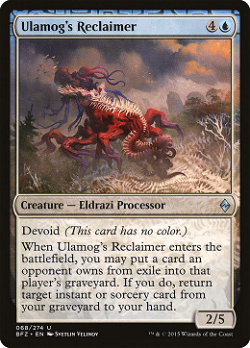About Ulamog's Reclaimer
Ulamog's Reclaimer, Creature — eldrazi processor, designed by Svetlin Velinov first released in Oct, 2015 in the set Battle for Zendikar.
A control or midrange deck with a focus on graveyard recursion and disruption would benefit from including Ulamog's Reclaimer in their strategy, as it provides a way to both disrupt the opponent's exile zone and retrieve valuable instant or sorcery cards from their own graveyard. While there may be more efficient options available for graveyard recursion in certain decks, Ulamog's Reclaimer's unique ability to interact with the opponent's exile zone could make it a valuable inclusion in specific metagames or matchups, potentially seeing play as a sideboard option in certain scenarios.
Rules
08/25/15
Cards with devoid use frames that are variations of the transparent frame traditionally used for Eldrazi. The top part of the card features some color over a background based on the texture of the hedrons that once imprisoned the Eldrazi. This coloration is intended to aid deckbuilding and game play.
08/25/15
Face-down cards in exile are grouped using two criteria: what caused them to be exiled face down and when they were exiled face down. If you want to put a face-down card in exile into its owner’s graveyard, you must first choose one of these groups and then choose a card from within that group at random. For example, say an artifact causes your opponent to exile their hand of three cards face down. Then on a later turn, that artifact causes your opponent to exile another two cards face down. If you use Wasteland Strangler to put one of those cards into their graveyard, you would pick the first or second pile and put a card chosen at random from that pile into the graveyard.
08/25/15
If a card loses devoid, it will still be colorless. This is because effects that change an object’s color (like the one created by devoid) are considered before the object loses devoid.
08/25/15
If a replacement effect will cause cards that would be put into a graveyard from anywhere to be exiled instead (such as the one created by Anafenza, the Foremost), you can still put an exiled card into its opponent’s graveyard. The card becomes a new object and remains in exile. In this situation, you can’t use a single exiled card if required to put more than one exiled card into the graveyard. Conversely, you could use the same card in this situation if two separate spells or abilities each required you to put a single exiled card into its owner’s graveyard.
08/25/15
Other cards and abilities can give a card with devoid color. If that happens, it’s just the new color, not that color and colorless.


— Comments 0
, Reactions 1
Be the first to comment